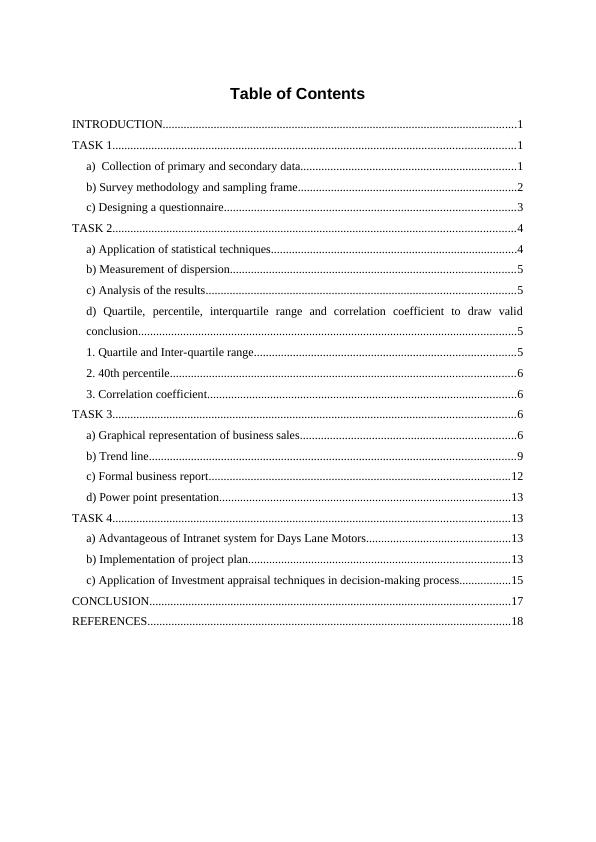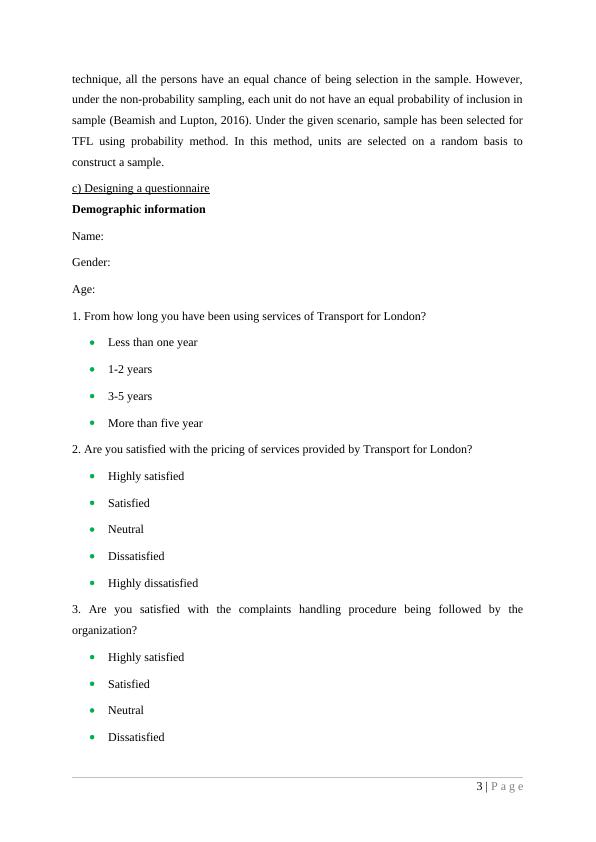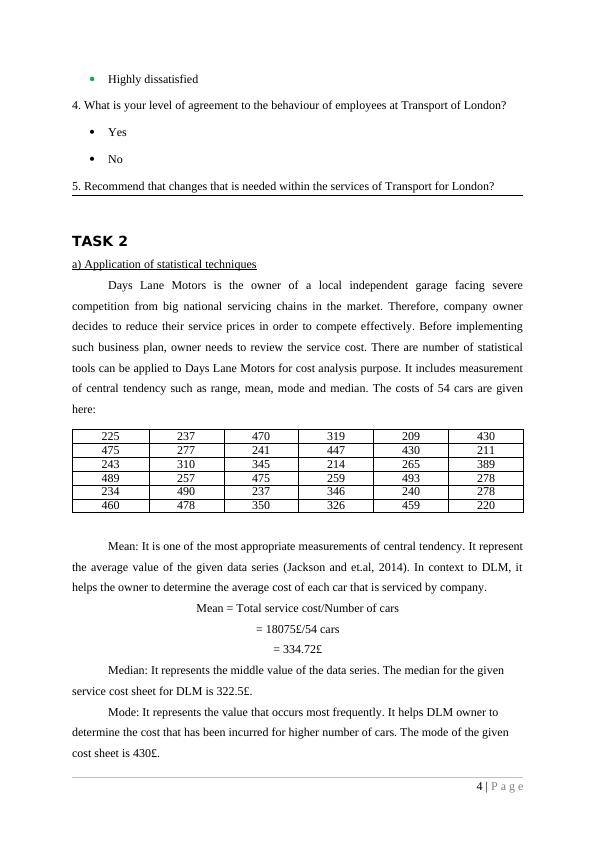Business Decision-Making Introduction
21 Pages4491 Words358 Views
Added on 2019-12-28
About This Document
BUSINESS DECISION-MAKING INTRODUCTION 1 TASK 11 a) Collection of primary and secondary data 1 b) Survey methodology and sampling frame 2 c) Designing a questionnaire 3 TASK 24 a) Application of statistical techniques 4 b) Measurement of dispersion 5 c) Analysis of the results5 d) Quartile, percentile, interquartile range and correlation coefficient to draw valid conclusion 5 1. Correlation coefficient6 TASK 36 a) Graphical representation of business sales6 b) Trend line 9 c
Business Decision-Making Introduction
Added on 2019-12-28
ShareRelated Documents
BUSINESS DECISION-MAKING

Table of ContentsINTRODUCTION......................................................................................................................1TASK 1......................................................................................................................................1a) Collection of primary and secondary data........................................................................1b) Survey methodology and sampling frame.........................................................................2c) Designing a questionnaire.................................................................................................3TASK 2......................................................................................................................................4a) Application of statistical techniques..................................................................................4b) Measurement of dispersion...............................................................................................5c) Analysis of the results.......................................................................................................5d) Quartile, percentile, interquartile range and correlation coefficient to draw validconclusion..............................................................................................................................51. Quartile and Inter-quartile range.......................................................................................52. 40th percentile...................................................................................................................63. Correlation coefficient.......................................................................................................6TASK 3......................................................................................................................................6a) Graphical representation of business sales........................................................................6b) Trend line..........................................................................................................................9c) Formal business report....................................................................................................12d) Power point presentation.................................................................................................13TASK 4....................................................................................................................................13a) Advantageous of Intranet system for Days Lane Motors................................................13b) Implementation of project plan.......................................................................................13c) Application of Investment appraisal techniques in decision-making process.................15CONCLUSION........................................................................................................................17REFERENCES.........................................................................................................................18

INTRODUCTIONDecision making plays a significant role in the organisation growth. It is a process ofgathering required information and takes qualified and strategic decisions for the businesssuccess. Transport for London often shortened to TFL is the local government body that isresponsible for making effective transport system in UK. The role of TFL is to implementtransport strategy and manage the UK transport system in an effective way. Headquarter ofTFL is established in Windor House, Victoria street, Westminster, London. In this report, therole of primary as well as secondary research analysis has been discussed for TFL. Moreover,various statistical as well as financial tools have been applied to take effective businessdecisions. TASK 1a) Collection of primary and secondary dataTransport for London organization should collect data from two sources that areprimary and secondary; they are described here as under:Primary sources: It is the direct way of gathering business information as it iscollected by researcher for the first time. Research conductor gathers required information tofind the best solution for a particular business problem. There are various sources available tocollect primary information that includes survey methodology, interviews, fieldworks, casestudy and observations. It requires a lot of time and money to collect information (Thomsen,2016). The benefit of this way of data collection is that it provides more reliable and accurateinformation to the researcher. Conducting surveys is the best way of collecting primaryinformation. Under this technique, investigator needs to decide their target market first. It is amarket at which research has been taken place. Thereafter, information can be collected bymaking questionnaire. It is a cost effective method and provides more reliable and prominentinformation and fulfil researcher’s objective in the best way. Transport for London can gathernecessary information to know the level of customer satisfaction through conducting surveys.The method helps to deliver significant and more accurate information to the organization. Secondary sources: Secondary source of information are the published sources as ithas been collected previously by the other investigators for their own purposes. There arenumerous ways available to gather information such as censuses, historical organizationalrecords, interview reviews, literature reviews, web searching, television, magazines, journalsand newspapers (Nastasi and Borja, 2016). Moreover, it can be collected by the publishedsources such as trade association reports, published commercial reports, governmental and1 | P a g e

agencies reports and other published economic reports. The benefit of the sources is that itconsume less time and spent less money in data collection process. TFL will be able to gatherinformation about the customer satisfaction from the historical organization records,economic reports and other published government reports. b) Survey methodology and sampling frameThe role of survey methodology and sampling frame in data collection process forTFL has been discussed here as under:Survey methodology: It is a way of studying a sample of units from overallpopulation. It provides assistance to the researcher in satisfying their data collectionrequirements. There are numerous ways available to TFL for conducting survey methodologythat is questionnaire, interviews and online surveys. Questionnaire consists of making a seriesof questions for gathering all the required information about the respondents. The benefits ofthis method it is a quicker and cheaper source of data collection. Researcher can constructnumber of questions and gather information from the respondent (Lowes and et. al., 2016).Another benefit of this method is it filled by respondent themselves hence, provide correctand fact information to the organization. Moreover, web questionnaire may be designed andsent through e-mails to the consumers helps to collect wider space information. Thus, helps tocollect information for a large number of samples. Moreover, interviews may also beconducted for data collection. In context to TFL, it can take telephone interviews andpersonal interviews also known as face to face interviews. In this method, researcher can askquestions to the respondents and gather necessary information. Furthermore, online surveyscan also be organized by TFL through using web technology. Sampling frame: Sample consist a number of units that has been selected from thetotal population or universe. In context to TFL, universe consists of all the persons who areusing the company services for travelling purpose. Thus, it is not possible for the researcherto study the entire universe as it takes a lot of time and the money. Therefore, sampling frameis a best technique that mitigates the requirement of study the universe through selecting asample. The sampling method is a way in which TFL needs to select an appropriate size ofsample that represents all the characteristics of the universe. The advantage of this method isthat it save researcher times and cost (Mintz and Wayne, 2016). Moreover, universe can beanalysed through making analysis of the representative sample only. Thus, it does not requireaddressing all the units for research purpose. Sample can be selected by two ways that areprobability sampling method and non-probability sampling. Under the probability sampling2 | P a g e

technique, all the persons have an equal chance of being selection in the sample. However,under the non-probability sampling, each unit do not have an equal probability of inclusion insample (Beamish and Lupton, 2016). Under the given scenario, sample has been selected forTFL using probability method. In this method, units are selected on a random basis toconstruct a sample.c) Designing a questionnaireDemographic informationName:Gender:Age:1. From how long you have been using services of Transport for London?Less than one year 1-2 years 3-5 years More than five year 2. Are you satisfied with the pricing of services provided by Transport for London? Highly satisfiedSatisfied Neutral Dissatisfied Highly dissatisfied3. Are you satisfied with the complaints handling procedure being followed by theorganization?Highly satisfiedSatisfied Neutral Dissatisfied 3 | P a g e

Highly dissatisfied4. What is your level of agreement to the behaviour of employees at Transport of London? YesNo5. Recommend that changes that is needed within the services of Transport for London?TASK 2a) Application of statistical techniquesDays Lane Motors is the owner of a local independent garage facing severecompetition from big national servicing chains in the market. Therefore, company ownerdecides to reduce their service prices in order to compete effectively. Before implementingsuch business plan, owner needs to review the service cost. There are number of statisticaltools can be applied to Days Lane Motors for cost analysis purpose. It includes measurementof central tendency such as range, mean, mode and median. The costs of 54 cars are givenhere:225237470319209430475277241447430211243310345214265389489257475259493278234490237346240278460478350326459220Mean: It is one of the most appropriate measurements of central tendency. It representthe average value of the given data series (Jackson and et.al, 2014). In context to DLM, ithelps the owner to determine the average cost of each car that is serviced by company.Mean = Total service cost/Number of cars= 18075£/54 cars= 334.72£Median: It represents the middle value of the data series. The median for the given service cost sheet for DLM is 322.5£.Mode: It represents the value that occurs most frequently. It helps DLM owner to determine the cost that has been incurred for higher number of cars. The mode of the given cost sheet is 430£.4 | P a g e

End of preview
Want to access all the pages? Upload your documents or become a member.
Related Documents
Assignment on Business Decision Making- UKCBClg...
|21
|4859
|74
Use of Primary and Secondary Sources of Data : Reportlg...
|22
|4530
|56
BUSINESS DECISION MAKING TABLE OF CONTENTSlg...
|23
|3822
|92
Business Decision Making Reportlg...
|22
|4797
|236
Unit 6: BUSINESS DECISION MAKINGlg...
|13
|431
|309
Business Decision-Making Table of Contentslg...
|34
|4560
|74
